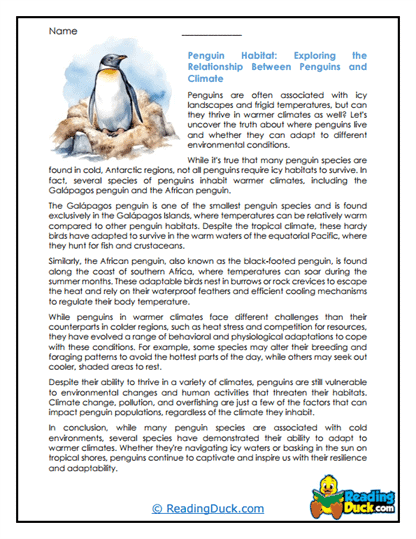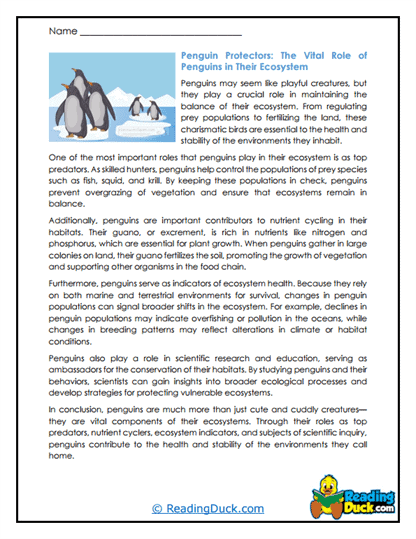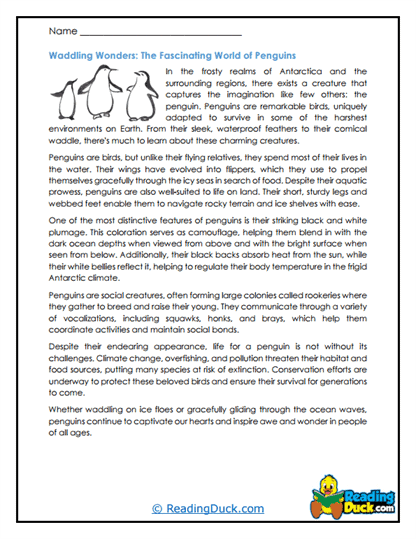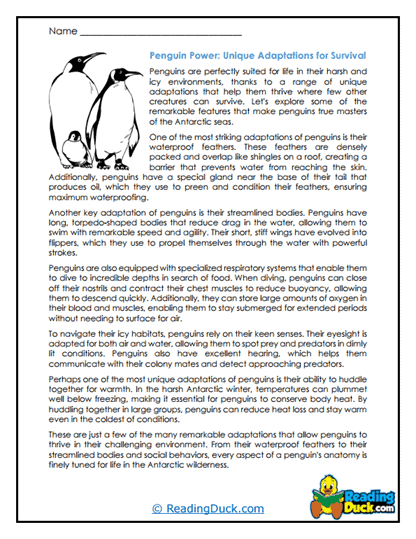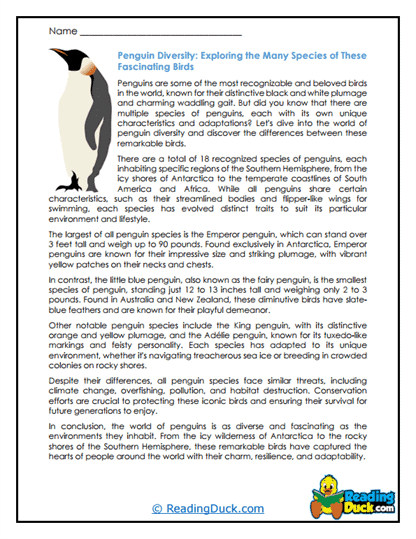Penguins Worksheets
About Our Penguin Worksheets
Our collection of Penguin worksheets offers an engaging and educational exploration into the world of one of the most beloved groups of birds, making it an excellent resource under the broader categories of Science: Biology and Animals. Penguins are fascinating creatures with unique adaptations that allow them to thrive in some of the harshest environments on Earth. These worksheets are designed to help students dive deep into the biology, behavior, and conservation of penguins, while also enhancing their reading comprehension and critical thinking skills.
This collection is a subtopic within Biology and Animals and contains several worksheet sets. Each worksheet set includes:
- Multiple Choice Questions: These questions assess students' comprehension of the reading passage, ensuring they grasp the key concepts and details presented.
- Short Answer Questions: This section prompts students to write their responses, encouraging them to articulate their understanding in their own words. This exercise helps reinforce their knowledge and improves their ability to communicate scientific information effectively.
- Open-Ended Questions: These questions invite students to share their personal thoughts, opinions, and reflections on the material, fostering critical thinking and allowing them to connect more deeply with the content.
Each worksheet is accompanied by a detailed answer key, making it easy for educators and parents to review students' work. The worksheets are provided in PDF format, ensuring they can be easily viewed electronically, downloaded, and printed.
Penguins: Masters of the Ice and Ocean
When introducing students to the topic of penguins, it’s important to highlight the unique characteristics that make these birds so special. Penguins are flightless birds, yet they are extraordinary swimmers, perfectly adapted to life in the ocean. They inhabit some of the most extreme environments on Earth, from the icy shores of Antarctica to the temperate islands off the coast of South America. Understanding penguins involves exploring their biology, behavior, and the various challenges they face in the wild.
To help students gain a comprehensive understanding of penguins, we can explore the topic through the following key areas:
Biology and Anatomy of Penguins: Penguins have a number of unique physical adaptations that allow them to survive and thrive in cold, aquatic environments:
- Streamlined Bodies: Penguins have sleek, torpedo-shaped bodies that allow them to swim with incredible speed and agility. Their wings have evolved into flippers, making them powerful swimmers capable of diving deep into the ocean to catch fish, squid, and other prey.
- Feathers and Insulation: Penguins have dense, overlapping feathers that provide excellent insulation against the cold. Beneath their feathers, they have a thick layer of blubber that helps them retain heat in icy waters.
- Unique Beaks and Feeding Habits: Penguins have sharp, hooked beaks that are ideal for catching slippery prey. They are also known for their unique feeding habits, which often involve regurgitating food to feed their chicks.
Penguin Species and Their Habitats: There are 18 species of penguins, each adapted to different environments, from the freezing cold of Antarctica to the temperate regions of South America and Africa:
- Emperor Penguins: The largest of all penguin species, Emperor penguins are known for their remarkable breeding behavior, which involves males incubating eggs on their feet through the harsh Antarctic winter while females hunt for food.
- Adelie Penguins: Smaller than Emperors, Adelie penguins are also native to Antarctica. They are known for their bold and curious nature and are often seen sliding on their bellies across the ice.
- King Penguins: Second in size only to the Emperor penguins, King penguins inhabit the sub-Antarctic islands. They are known for their long breeding cycle, which can last over a year from egg-laying to chick fledging.
- Galapagos Penguins: One of the smallest penguin species, the Galapagos penguin is the only penguin species found north of the equator. They have adapted to the warmer climate of the Galapagos Islands, where they rely on the cool waters of the Humboldt and Cromwell currents for food.
Social Behavior and Breeding: Penguins are highly social animals with complex behaviors that are crucial for their survival:
- Colony Life: Penguins often live in large colonies, sometimes numbering in the thousands. These colonies provide protection from predators and a social structure for breeding and raising chicks.
- Courtship and Mating: Penguins engage in elaborate courtship rituals, which can include vocal calls, bowing, and presenting pebbles or other objects as gifts. Once a pair bonds, they often mate for life, returning to the same nesting site year after year.
- Parental Care: Penguin parents share the responsibility of caring for their chicks. In many species, one parent will incubate the egg while the other hunts for food. Once the chick hatches, both parents take turns feeding and protecting it until it is old enough to fend for itself.
Challenges and Conservation: Despite their adaptability, penguins face numerous threats in the wild:
- Climate Change: The changing climate is one of the biggest threats to penguins. Warming temperatures and melting ice affect their breeding grounds and food supply. For example, Emperor penguins depend on stable sea ice to raise their chicks, and as the ice melts, their habitat becomes increasingly threatened.
- Overfishing: Overfishing in the oceans can lead to a decline in the fish stocks that penguins rely on for food. This can result in malnutrition and reduced breeding success, particularly for species like the African penguin, which is already endangered.
- Pollution: Oil spills, plastic waste, and other forms of pollution can have devastating effects on penguin populations. Oil can coat their feathers, reducing their insulating properties and making it difficult for penguins to stay warm in cold waters.
- Conservation Efforts: Many organizations are working to protect penguins through conservation efforts, including habitat preservation, anti-pollution campaigns, and legal protections. Public awareness and education are also critical in helping to reduce the threats that penguins face.
By exploring these aspects of penguins, students can develop a well-rounded understanding of these incredible birds. These worksheets will guide them through the biology, behavior, and conservation of penguins, sparking curiosity and encouraging them to think critically about the role penguins play in the global ecosystem and the importance of protecting them.
Creative Uses For These Worksheets
Integrating our Penguins worksheets into a school or homeschool curriculum offers numerous opportunities to enhance students' understanding of Biology and the animal kingdom. Here are some creative ideas on how educators and parents can effectively use these worksheets in various educational settings:
- Thematic Unit on Polar Biology: Incorporate the Penguins worksheets into a broader thematic unit on Polar Biology. Students can explore various aspects of life in polar regions, from the unique adaptations of polar animals to the impact of climate change on these fragile ecosystems. The worksheets on penguins can provide a focused study on how one group of animals has evolved to thrive in the harsh conditions of the Antarctic and sub-Antarctic regions.
- Interactive Learning Stations: Set up interactive learning stations around the classroom, each focusing on a different aspect of penguin biology and behavior. Students can rotate through the stations, completing a worksheet at each one. Stations could include topics like penguin anatomy (with models or diagrams), penguin communication (with recordings of penguin calls), and conservation challenges (with case studies of endangered penguin species).
- Research Projects and Presentations: Assign students a project where they research a specific species of penguin, create a report or presentation, and share their findings with the class. The worksheets can serve as a starting point for their research, providing them with foundational knowledge that they can build upon. Projects could include topics like the breeding behaviors of Emperor penguins, the adaptations of Galapagos penguins to a tropical environment, or the conservation efforts to protect the African penguin.
- Field Trips and Virtual Tours: While visiting penguins in their natural habitat might not be feasible, consider organizing a field trip to a local zoo or aquarium that houses penguins. Before the trip, use the worksheets to prepare students by teaching them about penguin behavior and anatomy. If a physical trip is not possible, virtual tours of places like the Penguin Parade at Phillip Island Nature Parks or online presentations from marine biologists can provide an engaging alternative.
- Multimedia Integration: Pair the worksheets with documentaries, videos, or interactive apps about penguins. For example, students can watch a documentary on the life cycle of Emperor penguins and then complete the worksheets to reinforce what they’ve learned. Using multimedia can cater to different learning styles and help make the topic more engaging and accessible.
By incorporating these Penguins worksheets into the curriculum, teachers and parents can provide students with a comprehensive and engaging learning experience. These worksheets are designed to help students explore the biology, behavior, and conservation of penguins, develop critical thinking skills, and foster a lifelong curiosity about the natural world. Whether used in the classroom or at home, these resources will inspire students to appreciate the incredible adaptations and resilience of penguins and understand the importance of protecting these remarkable birds for future generations.
